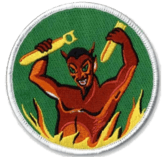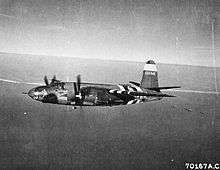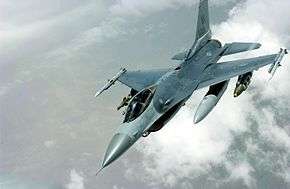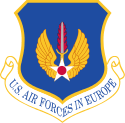555th Fighter Squadron
555th Fighter Squadron
 | |
|---|---|
|
Over Iraq, a Squadron F-16C Fighting Falcon peels away from a KC-135 Stratotanker from the 92d Air Refueling Squadron | |
| Active | 1942–1945; 1964–1994; 1994–present |
| Country |
|
| Branch |
|
| Role | Fighter |
| Part of | United States Air Forces in Europe |
| Garrison/HQ | Aviano Air Base |
| Nickname(s) | Triple Nickel |
| Motto(s) | Once Green, Always Green |
| Colors | Green |
| Engagements |
Linebacker I Linebacker II |
| Decorations |
Distinguished Unit Citation Presidential Unit Citation Air Force Outstanding Unit Award with Combat "V" Device Air Force Outstanding Unit Award Republic of Vietnam Gallantry Cross with Palm |
| Commanders | |
| Current commander | LtCol John Peterson |
| Notable commanders |
Joseph Kittinger David L. Goldfein |
| Insignia | |
| 555th Fighter Squadron emblem (approved 29 August 2007)[1] |
 |
| 555th Tactical Fighter Squadron emblem (approved 13 March 1975)[1] |
 |
| 555th Bombardment Squadron emblem[2] |
 |
The 555th Fighter Squadron is part of the 31st Operations Group at Aviano Air Base, Italy. It operates General Dynamics F-16 Fighting Falcon aircraft conducting an air superiority mission.
Mission
The 555th Fighter Squadron provides combat airpower on demand to U.S. and NATO Combatant Commanders as well as the National Command Authority in order to meet National Security objectives.
It also performs air and space control and force application roles of counterair, strategic attack and counterland, including interdiction and close-air support, with 21 F-16CMs employing state of the art munitions in support of the joint, NATO, and combined operations.
History
World War II

![]() Media related to 386th Bombardment Group at Wikimedia Commons
Media related to 386th Bombardment Group at Wikimedia Commons
The squadron's heritage began on 25 November 1942 when the 555th Bombardment Squadron, Medium, was constituted flying the Martin B-26 Marauder. During World War II, the 555th led offensive actions against Axis forces from bases in England, France, and Belgium. For gallantry in action, the squadron was awarded the first of its four Presidential Unit Citations.[3] The squadron was inactivated shortly after the war ended.
Vietnam Era

On 8 January 1964, the 555th re-emerged at MacDill Air Force Base, Florida, operating the McDonnell Douglas F-4C Phantom II. The squadron was organized from elements of the 557th, 558th and 559th TFS at MacDill, when the parent 12th Tactical Fighter Wing(TFW) reduced the number of aircraft from three squadrons of 25 aircraft each to four squadrons of 18 aircraft.
The conflict in Southeast Asia was escalating and throughout 1965 the wing supported Pacific Air Forces (PACAF) Contingency Operations by rotating combat squadrons quarterly to Naha AB, Okinawa, in the Ryukyu Islands. At Naha AB the squadrons were part of the 51st Fighter Interceptor Wing(FIW)and performed as Air Defense Interceptor Squadrons for the Ryukyu Islands. The 555th had flown its planes to Naha AB in December 1964 on the first three-month rotation. Later, the 555th was chosen to return to Naha AB and left MacDill AFB on 6 November 1965 by C-135 transports. The 555th relieved the 559th at Naha and its assets. The 12th TFW was slated to open Cam Ranh Bay AB, South Vietnam(RVN). The air defense mission in Okinawa could not be abandoned and a decision was made to keep the 555th there until a replacement unit could be identified. The remainder of the 12th TFW deployed to Cam Ranh Bay beginning in November 1965. An F-102 squadron at Hamilton AFB, CA, was picked to replace the 555th at Naha. The F-102 was not able to air refuel so the planes were modified to a probe and drouge refueling configuration and the pilots trained to perform air refueling, a new concept for an interceptor squadron. The F-102s arrived at Naha in late February 1966. A decision was made to send the 555th to Udorn Royal Thai Air Force Base(RTAFB) in Northern Thailand, near Vientiane, Laos, and not to join the other three 12th TFW squadrons at Cam Ranh Bay. Cam Ranh could hold only four F-4C squadrons. 391 TFS had arrived at Cam Ranh awaiting runway construction at Phan Rang. Until the 391st rejoined 366th TFW, the 12th could not accommodate the 555th (lack of space). The decision to assign 555th at Udorn was validated in April 1966 when the 555th downed five Migs. A sixth Mig was downed by an F-4C from DaNang AB, RVN. Udorn RTAFB was small and when a squadron of F-104As was brought there, it was decided to send two Flights, half the 555th squadron, to Ubon RTAFB. There was not enough billeting for the entire 555th and what was available was not adequate for daytime rest. The 8th TFW was the resident unit at Ubon and were flying only night missions(Night Owl) into North Vietnam. The first two weeks at Ubon, the 555th planes flew day strikes into North Vietnam. A barracks type building was hastily constructed to house the entire 555th and the remaining half of the 555th was brought to Ubon in July 1966 and the entire squadron then began flying Night Owl missions. The new building was not air-conditioned and so the 555th flew the sunset to about 2300 hours. The two squadrons of the 8th TFW flew the missions from 2300 to sunrise. Later in 1966 the 555th was transferred from the 12thTFW into the 8th TFW.
The 8thTFW later became known as the "Wolfpack". The 555th led the first strike against MiG airfields in North Vietnam. The 555 TFS launched night bombing attacks against North Vietnam on 29 September 1967. While at Ubon, the 555th downed additional Migs, including four Mikoyan-Gurevich MiG-21s on 2 January 1967. The unit thus became the only "Quad Ace" Fighter Squadron to that point, with 20 MiGs to its credit.[3]
In 1968, the Nickel participated in the campaign against the Ho Chi Minh Trail and the Linebacker campaigns against the North Vietnam heartland in 1972. During Linebacker I and Linebacker II, the 555th returned to its air superiority role and brought its MiG tally to 39 confirmed victories—10 MiG-17s, 3 MiG-19s, and 26 MiG-21s, producing the first and second USAF aces, and earning the motto, "World's Largest Distributor of MiG Parts". From 1966 to 1973, the 555th Tactical Fighter Squadron earned three more Presidential Unit Citations, five Air Force Outstanding Unit Awards with combat "V" device, the Republic of Vietnam Gallantry Cross with palm, and the 1973 Hughes achievement award.[3]
After nine years of combat operations, the 555th returned to the United States. In 1974, the squadron moved to Luke Air Force Base, Arizona, where it transitioned to the McDonnell Douglas F-15 Eagle and became part of the 405th Tactical Training Wing, training pilots transitioning to the F-15 Eagle.
Reactivation in Italy
On 1 April 1994, the unit was reassigned to NATO and stationed at Aviano Air Base, Italy, absorbing the General Dynamics F-16 Fighting Falcon and equipment of the inactivated 526th Fighter Squadron, which had been inactivated at Ramstein AB, Germany when the 86th FW became an airlift wing (86th AW). At Aviano, the squadron returned to its previous mission as an operational combat fighter squadron.[3]
2013 Sequestration
Air Combat Command officials announced a stand down and reallocation of flying hours for the rest of the fiscal year 2013 due to mandatory budget cuts. The across-the board spending cuts, called sequestration, took effect 1 March when Congress failed to agree on a deficit-reduction plan.[6]
Squadrons either stood down on a rotating basis or kept combat ready or at a reduced readiness level called "basic mission capable" for part or all of the remaining months in fiscal 2013.[6] This affected the 555th Fighter Squadron with a stand-down grounding from 9 April-30 September 2013.[6]
Operations
- World War II
- Vietnam War
- Operation Deny Flight
- Operation Deliberate Force
- Operation Deliberate Guard
- Operation Allied Force[1]
Lineage
- Constituted as the 555th Bombardment Squadron (Medium) on 25 November 1942
- Activated on 1 December 1942
- Redesignated: 555th Bombardment Squadron, Medium on 9 October 1944
- Redesignated: 555th Bombardment Squadron, Light on 23 June 1945
- Inactivated on 7 November 1945
- Redesignated 555th Tactical Fighter Squadron, activated and organized, on 8 January 1964
- Redesignated 555th Tactical Fighter Training Squadron on 5 July 1974
- Redesignated 555th Fighter Squadron on 1 November 1991
- Inactivated on 25 March 1994
- Activated on 1 Apr 1994[1]
Assignments
- 386th Bombardment Group, 1 December 1942 – 7 November 1945
- 12th Tactical Fighter Wing, 8 January 1964 (attached to 51st Fighter Interceptor Wing, 12 Dec 1964 – 9 Mar 1965, 11 December 1965 - 21 February 1966, 8th Tactical Fighter Wing, c. after 22 February 1966)
- Thirteenth Air Force, 4 Mar 1966 (attached to 8th Tactical Fighter Wing until 24 March 1966)
- 8th Tactical Fighter Wing, 25 March 1966
- 432d Tactical Reconnaissance Wing, 1 June 1968
- 58th Tactical Fighter Wing (later 58 Tactical Training Wing), 5 July 1974
- 405th Tactical Training Wing, 29 August 1979
- 58th Operations Group, 1 October 1991 – 25 March 1994
- 31st Operations Group, 1 April 1994 – present[1]
Stations
|
|
Aircraft
- Martin B-26 Marauder (1943–1945)
- Douglas A-26 Invader (1945)
- McDonnell Douglas F-4 Phantom II (1964–1974)
- McDonnell Douglas F-15 Eagle (1974–1994)
- F-16C/D block 40 Fighting Falcon (1994 – present)[1]
References
- Notes
- ↑ "The Yankee Guerilla" was a Martin B-26C-15-MO Marauder serial 41-34946. its pilot lost control of the aircraft while returning from a 5 October 1944 mission in the area of Duren Barracks in Southwestern Germany. The plane crashed into a vacant house 5 miles Northwest of Compeigne, France.
- ↑ Aircraft is McDonnell F-4D-28-MC Phantom Serial 65-683. Taken on 20 January 1972. This aircraft was retired to AMARC on 6 May 1988 and scrapped on 2 January 1997.
- Citations
- 1 2 3 4 5 6 7 Dollman, TSG David (October 16, 2016). "Factsheet 555 Fighter Squadron (USAFE)". Air Force Historical Research Agency. Retrieved November 23, 2016.
- ↑ Watkins, pp. 72-73
- 1 2 3 4 "Fact Sheets: 555th Fighter Squadron "Triple Nickle"". 31st Fighter Wing Public affairs. April 15, 2009. Archived from the original on December 17, 2013. Retrieved November 24, 2016.
- ↑ Martin
- ↑ Baugher, Joe (12 December 2009). "USAAS-USAAC-USAAF-USAF Aircraft Serial Numbers--1908 to present". Archived from the original on 22 January 2010.
- 1 2 3 "Reduced flying hours forces grounding of 17 USAF combat air squadrons". Air Force Times.
Bibliography
![]() This article incorporates public domain material from the Air Force Historical Research Agency website http://www.afhra.af.mil/.
This article incorporates public domain material from the Air Force Historical Research Agency website http://www.afhra.af.mil/.
- Martin, Patrick (1994). Tail Code: The Complete History of USAF Tactical Aircraft Tail Code Markings. Schiffer Military Aviation History. ISBN 0-88740-513-4.
- Maurer, Maurer, ed. (1983) [1961]. Air Force Combat Units of World War II (PDF) (reprint ed.). Washington, DC: Office of Air Force History. ISBN 0-912799-02-1. LCCN 61060979.
- Maurer, Maurer, ed. (1982) [1969]. Combat Squadrons of the Air Force, World War II (PDF) (reprint ed.). Washington, DC: Office of Air Force History. ISBN 0-405-12194-6. LCCN 70605402. OCLC 72556.
- Ravenstein, Charles A. (1984). Air Force Combat Wings, Lineage & Honors Histories 1947-1977 (PDF). Washington, DC: Office of Air Force History. ISBN 0-912799-12-9.
- 555th Fighter Squadron Fact Sheet
External links
| Wikimedia Commons has media related to 555th Fighter Squadron (United States Air Force). |


